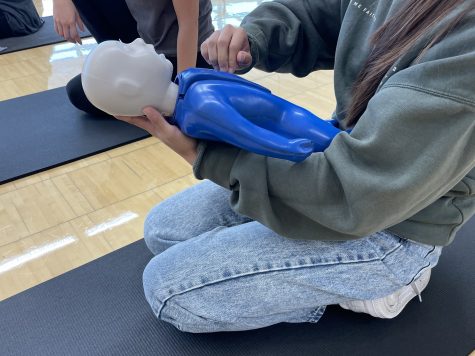Long Beach State held its first Heartsaver CPR certification training class on Friday in the Student Recreation and Wellness Center.
The class focused on preparing participants for a situation in which they may need to administer first aid to an unconscious or awake person. Teachings included the basics of first aid, rescue breathing, cardiopulmonary resuscitation (CPR) and automated external defibrillator (AED) procedures.
Aquatics coordinator and emergency instructor Michael Freeman taught the class to a group of nine CSULB students who paid for the class in advance.
Freeman not only stressed the importance of looking out for one another, but also the importance of looking out for oneself. He shared an anecdote about a speed racing incident in which two uninvolved people were electrocuted after trying to help the injured.
“We can’t help others before we help ourselves,” Freeman said. “We can’t protect others before we protect ourselves. A hero is someone who has been lucky. I don’t want you to deal with luck, I want you to go home to your family and your life.”

Freeman urged participants to always inspect the scene and check their surroundings before stopping to help someone.
Personal protective equipment was given to every student to demonstrate how to avoid mouth-to-mouth contact and stay protected from disease when performing CPR. Freeman also noted counting out loud can help one stay calm and collected in an emergency situation.
The hands-on training involved the use of adult and infant dummies. They were used by the class to practice every step of vital checks, rescue breathing and CPR.
Freeman taught the class how to check for pulse, consciousness and breathing before attempting to give CPR. They were also instructed on the different procedures to use depending on the size and age of the person they were aiding.
Freeman said that a small body, such as that of an infant or child, requires a different posture and pressure on their chest during compressions than an adult.

Students were told to call 911 immediately after checking the consciousness of someone in need of immediate medical attention unless they are alone with an infant and have no cell phone with them.
“If no one is around and you have no available cell phone after checking for vitals, you should first do 5 rounds of CPR before calling 911,” Freeman said in an email follow up. “The baby is more likely to go into respiratory distress faster.”
Participants were shown a demonstration of CPR on both an adult and infant dummy and then asked to recreate the procedure on their dummies. This included practicing form and timing for compressions.
Freeman provided the class with several examples of popular songs that can be used for timing compressions, including “Another One Bites the Dust” by Queen and “The Imperial March” by John Williams, from the “Star Wars” franchise.
Cardiopulmonary resuscitation (CPR) is used to get blood pumping after the heart has stopped, but it does not get the heart pumping again. Participants were given a lesson on how to use an Automated External Defibrillator (AED) to show them how to get a person’s heart pumping and back in rhythm again.
Freeman showed the class where to place the defibrillator pads and told trainees to always take note of any piercings, jewelry, pregnancy or other details of a person that may cause complications before they begin to use an AED.
While the class concluded with a reminder for participants to take into consideration any allergies and illnesses before they tend to an injured person, students left the class with a variety of tools to help those in emergency situations.
“I’m here for my student teaching,” Maya Langarica, an education major, said. “But I hope to learn the basic skills to help out in an emergency in any way I could.”
Specific procedures and differences in First Aid/CPR/AED guidelines for adults, children and infants can be found on the American Heart Association website.




